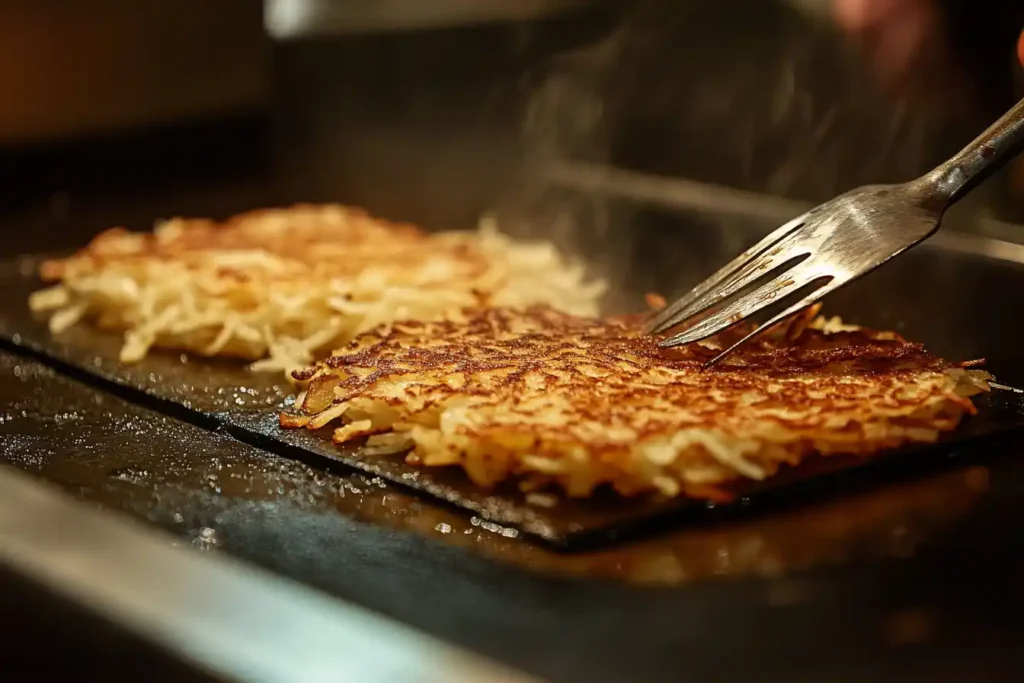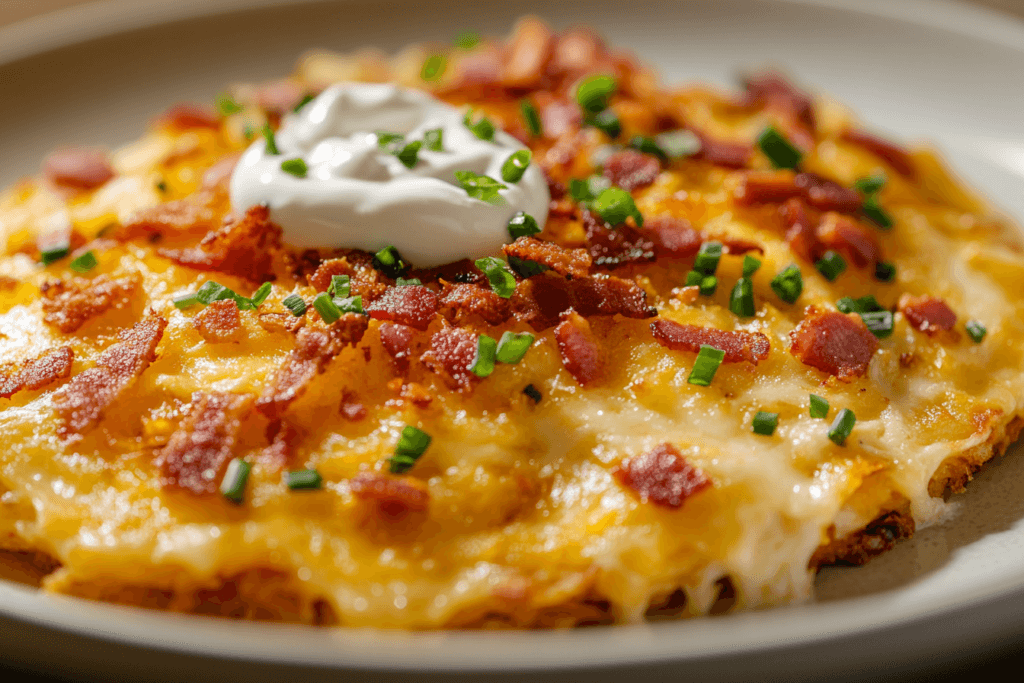Have you ever wondered why restaurant hash browns taste so irresistibly good compared to homemade ones? Whether you’re enjoying breakfast at a diner or brunch at a fancy café, those golden, crispy potatoes seem to melt in your mouth with the perfect combination of flavor and texture. But what’s the secret?
The truth is, restaurants use a combination of top-quality ingredients, special cooking techniques, and professional-grade equipment to achieve that mouthwatering flavor and satisfying crunch. From choosing the right potatoes to using secret seasonings and oils, there’s a lot that goes into making those hash browns absolutely delectable.
In this article, we’ll break down the hidden tricks and techniques that restaurants use to elevate hash browns to culinary perfection. We’ll also share tips so you can recreate those flavors at home without breaking a sweat.
Table of Contents
The Appeal of Perfect Hash Browns
Crispiness vs. Softness – The Perfect Texture
One of the defining characteristics of restaurant hash browns is their delicate balance of textures. On the outside, they’re crispy and golden brown, while the inside remains soft, fluffy, and almost creamy. This contrast makes every bite satisfying and memorable.
Restaurants often achieve this texture by using griddles that distribute heat evenly, ensuring a consistent crust without burning. Additionally, they carefully prep potatoes by removing excess moisture, which helps the exterior crisp up instead of steaming.
Flavor Explosion – The Secret to Delicious Taste
Beyond the texture, the flavor of restaurant hash browns stands out. It’s not just about potatoes and salt—many restaurants add seasonings, butter, and oils that enhance the natural taste. Some even mix in finely chopped onions or garlic for an extra burst of flavor.
The secret also lies in the browning process, where the sugars in the potatoes caramelize, creating rich, nutty undertones. This flavor depth can be hard to replicate at home without understanding the right methods, but we’ll uncover these secrets as we go deeper.
Ingredients That Make Restaurant-Style Hash Browns Taste Better
High-Quality Potatoes – The Base Ingredient
Restaurants don’t settle for just any potatoes. They often use Russet potatoes because of their high starch content and low moisture levels, which contribute to a crispier texture. Some may opt for Yukon Gold potatoes for a creamier interior.
To achieve restaurant-quality hash browns, chefs also ensure the potatoes are peeled, shredded, and rinsed thoroughly to remove starch before cooking. This step prevents them from becoming gummy or sticky during frying.
Butter vs. Oil – Which Makes Restaurant Hash Browns Taste So Good?
The choice between butter and oil—or sometimes both—makes a significant difference. Butter adds a rich, creamy flavor, while oils with a high smoke point like canola or vegetable oil allow for crispier browning without burning.
Restaurants often combine the two, starting with oil for frying and adding a touch of butter at the end for flavor. This layering of fats creates a balance of crunch and richness that’s hard to resist.
Seasonings and Spices – Flavor Boosters
Salt and pepper might be standard, but many restaurants go the extra mile with seasoning blends that include garlic powder, onion powder, paprika, and even a dash of cayenne for a slight kick.
Some chefs use herb-infused oils or sprinkle fresh herbs like parsley or chives on top before serving, adding a gourmet touch that elevates both the taste and presentation.
Cooking Techniques That Enhance Flavor

Griddle Cooking – The Golden Secret
One of the biggest reasons restaurant hash browns taste so good is the use of large flat-top griddles. These griddles allow for even heat distribution, ensuring that the potatoes cook uniformly and develop a golden-brown crust without burning.
Unlike home stovetops, which often create hot spots, restaurant griddles maintain a steady temperature, perfect for caramelizing the potatoes and locking in flavor. This even cooking surface also helps chefs flip and press the hash browns to create layers of crispiness.
Prepping Potatoes – Soaking and Drying Methods
Restaurants take extra time to prep potatoes properly—a step many home cooks overlook. After shredding, the potatoes are soaked in cold water to remove excess starch. This process prevents them from sticking together and becoming mushy during frying.
After soaking, the potatoes are thoroughly dried using towels or salad spinners. Removing moisture ensures that they fry instead of steaming, creating a crispy crust instead of a soggy texture.
Pro Tip: Some chefs also parboil potatoes before shredding to partially cook the interiors, allowing them to finish perfectly on the griddle.
Layering and Frying – Achieving Even Browning
Restaurants don’t just dump shredded potatoes into the pan. Instead, they carefully layer them into thin, flat piles and press them down for even cooking. This technique maximizes surface contact, resulting in an extra-crispy crust.
Many chefs also flip hash browns only once to avoid breaking them apart, preserving their structure while ensuring both sides are golden brown.
Additionally, restaurants often cook hash browns in small batches to avoid overcrowding the pan. Overcrowding causes steam buildup, which prevents browning and leads to soggy potatoes.
Restaurant Equipment vs. Home Cooking Tools
High-Temperature Griddles – Better Cooking Surfaces
Professional kitchens use industrial griddles capable of maintaining high, consistent temperatures—something most home stovetops struggle to match. This steady heat is crucial for even cooking and crispiness.
For home cooks, cast-iron skillets or non-stick frying pans can mimic the effect of a restaurant griddle. Preheating these pans thoroughly before adding the potatoes is key to getting a crispy crust.
Oil Distribution – The Key to Even Crispiness
Restaurants often use squeeze bottles or brushes to evenly distribute oil across the griddle. This technique prevents pockets of oil, ensuring the hash browns fry uniformly without becoming greasy.
Home cooks can achieve similar results by brushing oil onto the pan or using a spray bottle to apply a light coating.
Professional Seasoning Techniques – Consistency in Flavor
Chefs frequently season hash browns in layers—adding salt and spices at different stages of cooking rather than just at the end. This method allows the flavors to infuse the potatoes, creating a deeper, more satisfying taste.
To replicate this at home, try seasoning both the shredded potatoes before frying and the final product immediately after cooking while they’re still hot. This ensures maximum flavor absorption.
Special Additions That Elevate Taste

Onions, Garlic, and Cheese – Flavor Enhancers
Restaurants often add finely chopped onions or garlic to the potatoes before cooking, adding layers of flavor that make the hash browns more savory. Some even mix in cheddar cheese or Parmesan for an extra burst of richness.
For a gourmet twist, try mixing in caramelized onions or roasted garlic at home. These ingredients not only add flavor but also create a slight sweetness that balances the salty, crispy potatoes.
Fresh Herbs and Garnishes – A Gourmet Touch
Restaurants sometimes finish their hash browns with a sprinkle of fresh herbs like parsley, dill, or chives. These additions not only enhance the flavor but also make the dish visually appealing.
Pro Tip: Adding a dollop of sour cream or a drizzle of hollandaise sauce can transform hash browns into a luxury side dish.
Meat and Bacon Infusions – Savory Combinations
To make hash browns even more indulgent, some restaurants add bits of bacon, ham, or sausage directly into the mix. The fat from these meats enhances the potatoes’ flavor, creating a richer and more satisfying bite.
For home versions, cook and crumble bacon ahead of time, mixing it into the potatoes before frying to replicate that restaurant-style decadence.
Secrets to Achieving Restaurant-Style Hash Browns at Home
Picking the Right Potatoes – Russet or Yukon Gold?
One of the first steps to recreating restaurant-style hash browns at home is choosing the right type of potato. Restaurants often favor Russet potatoes due to their high starch content, which helps achieve a crispy exterior and fluffy interior.
Alternatively, Yukon Gold potatoes are sometimes used for a creamier texture, ideal for softer hash browns. The key is to avoid waxy potatoes like red potatoes, as they tend to retain too much moisture and resist crisping.
Pro Tip: For maximum crispiness, refrigerate the shredded potatoes for about 30 minutes before cooking to reduce moisture further.
Mastering the Shredding Process – Consistency Matters
Restaurants often use commercial-grade shredders that produce evenly sized potato strands, which cook uniformly. At home, a box grater or a food processor with a grating attachment can replicate this effect.
Once shredded, it’s essential to rinse the potatoes under cold water to remove excess starch. After rinsing, pat them completely dry using paper towels or a clean kitchen towel. Any residual moisture can cause the potatoes to steam instead of fry, ruining the crispiness.
Pro Tip: For ultra-crispy hash browns, squeeze the shredded potatoes in a cheesecloth to extract as much water as possible.
Optimal Frying Methods – Stovetop or Oven?
Restaurants primarily use flat-top griddles, but you can still achieve similar results at home with a cast-iron skillet or non-stick pan. Preheating the pan over medium-high heat is crucial for crisping the potatoes immediately upon contact.
Stovetop Method:
- Preheat your pan and add a generous amount of oil with a high smoke point (canola, vegetable, or peanut oil).
- Spread the shredded potatoes in a thin, even layer and press down with a spatula.
- Cook undisturbed for 4–5 minutes per side, flipping only once to maintain the structure.
Oven Method:
If you prefer less oil, try baking the hash browns in the oven:
- Preheat the oven to 425°F (220°C) and line a baking sheet with parchment paper.
- Toss the shredded potatoes with a light coating of olive oil and seasonings.
- Spread them evenly on the sheet and bake for 20–25 minutes, flipping halfway through for even browning.
Pro Tip: Finish hash browns under the broiler for 2–3 minutes to add an extra layer of crispiness.
Common Mistakes When Making Hash Browns
Overcrowding the Pan – Why It Ruins Texture
One of the most common errors when cooking hash browns is overcrowding the pan. Packing too many potatoes into one pan leads to steaming instead of frying, resulting in a soggy texture rather than a crispy crust.
To fix this, always cook hash browns in batches if necessary, allowing enough space for each portion to crisp evenly.
Not Draining Moisture – The Enemy of Crispiness
Failing to drain the moisture from shredded potatoes is another frequent mistake. Moist potatoes steam instead of fry, preventing that golden crust from forming.
Always squeeze out excess water using a towel or cheesecloth and let the potatoes air-dry briefly before cooking.
Skipping Pre-Seasoning – Missing the Flavor Foundation
Restaurants carefully season potatoes at every step of the process. Many home cooks add salt and spices only at the end, missing the opportunity to layer flavors.
Instead, toss the shredded potatoes with salt, pepper, garlic powder, and paprika before cooking. This ensures the seasonings penetrate every bite and complement the natural flavors of the potatoes.
Pro Tip: For a gourmet twist, try adding a pinch of smoked paprika or cumin for a deeper flavor profile.
FAQs About Restaurant Hash Browns
Why do restaurant hash browns stay crispier than homemade ones?
Restaurants achieve crispier hash browns by thoroughly removing moisture from shredded potatoes and cooking them on high-temperature griddles. The even heat distribution and consistent oil application create a perfect crispy crust. At home, using a cast-iron skillet and drying potatoes well can help replicate this result.
What oil do restaurants use for hash browns?
Most restaurants use canola oil or vegetable oil because of their high smoke points, ensuring the potatoes crisp without burning. Some also add butter for a richer flavor after the initial frying.
How do restaurants shred potatoes so finely?
Restaurants often use industrial-grade shredders that produce even strands of potatoes. At home, a box grater or a food processor with a shredding attachment can mimic this effect. Consistency in shredding ensures even cooking.
Can I make hash browns ahead of time?
Yes! You can par-cook hash browns by frying them lightly and storing them in the fridge. When ready to serve, reheat them in a hot skillet or oven to restore crispiness.
Are frozen hash browns as good as fresh ones?
Frozen hash browns can be convenient but may lack the fresh taste and crispiness of homemade or restaurant-style hash browns. If using frozen ones, thaw them completely and pat them dry before cooking to improve texture.
What’s the secret ingredient in restaurant hash browns?
The secret lies in the combination of butter and oil, perfect seasoning, and layered cooking techniques. Some restaurants also add onions, garlic, or cheese to create extra depth of flavor.
Conclusion
Restaurant hash browns taste so good because of quality ingredients, expert techniques, and professional equipment that create the perfect balance of crispy exteriors and soft, fluffy interiors. From using Russet potatoes and removing excess moisture to frying on hot griddles with a mix of oil and butter, restaurants master every step to enhance flavor and texture.
By choosing the right potatoes, prepping them properly, and cooking in layers with the right seasonings, you can easily recreate restaurant-quality hash browns at home. With a little patience and practice, your hash browns can be just as irresistible as the ones served at your favorite breakfast spot!
Curious about more hash brown tricks? Learn how to turn French fries into hash browns or explore hash browns with French fries. You might also enjoy reading about why restaurant pancakes are so fluffy.

